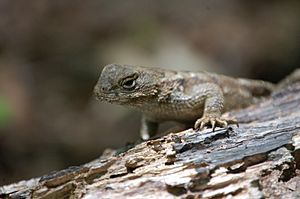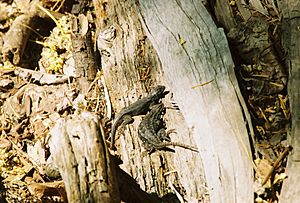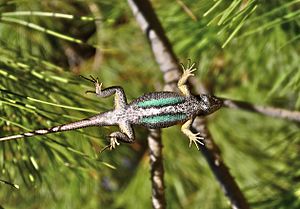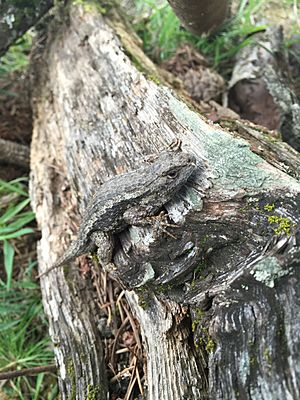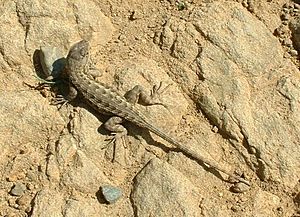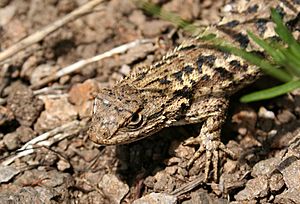Western fence lizard facts for kids
Quick facts for kids Western fence lizard |
|
|---|---|
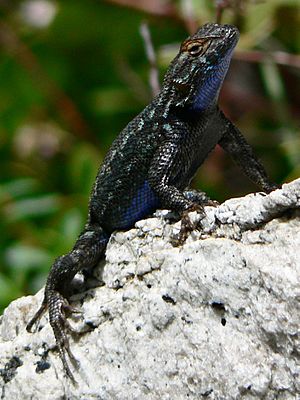 |
|
| S. o. taylori | |
| Scientific classification |
The western fence lizard (Sceloporus occidentalis) is a common lizard found in many parts of western North America. You can spot them in places like California, Oregon, Washington, Idaho, Nevada, Utah, Arizona, and even northern Mexico. These lizards are often called "blue-bellies" because adult males have bright blue patches on their undersides. They belong to a group of lizards known as spiny lizards.
Contents
Lizard Families
Scientists group living things into categories. This helps us understand how different animals are related. The western fence lizard belongs to the order Squamata, which includes all snakes and lizards. It is also part of the suborder Iguania.
The family it belongs to has been a topic of discussion among scientists. Most experts now place it in the family Phrynosomatidae.
Types of Western Fence Lizards
There are six recognized types, or subspecies, of the western fence lizard:
- Island fence lizard, Sceloporus occidentalis becki
- San Joaquin fence lizard, Sceloporus occidentalis biseriatus
- Coast Range fence lizard, Sceloporus occidentalis bocourtii
- Great Basin fence lizard, Sceloporus occidentalis longipes
- Northwestern fence lizard, Sceloporus occidentalis occidentalis
- Sierra fence lizard, Sceloporus occidentalis taylori
Some scientists think the island fence lizard might be its own separate species. However, new studies looking at lizard DNA suggest there might be even more types. This means the way we group these lizards might change in the future.
How to Identify Them
Western fence lizards are usually about 5.7 to 8.9 centimeters (about 2 to 3.5 inches) long from their snout to the base of their tail. Their total length, including the tail, can be around 21 centimeters (about 8 inches).
They can be brown or black, sometimes with sandy or greenish shades. They often have black stripes on their backs. The most special thing about them is their bright blue bellies. Their legs also have yellow undersides. Males have clear blue patches on their throats and bellies. These bright colors are usually faint or missing in females and young lizards. Some males even have shiny, bright blue spots on their backs.
Their scales are rough and pointed, which gives them their "spiny" look.
Similar Lizards
Many other lizards have blue coloring. Here is how to tell them apart:
- The eastern fence lizard (S. undulatus) has two small blue patches on its throat instead of one large one.
- The sagebrush lizard (S. graciosus) does not have yellow on its legs and has smaller scales on its back.
- The side-blotched lizard (Uta stansburiana) often has a black spot behind its front leg.
Where They Live
The western fence lizard is most common in California. But you can also find it in parts of Oregon, Washington, Idaho, Nevada, Utah, Arizona, and northwestern Baja California in Mexico. They also live on some islands off the coasts of California and Baja California.
These lizards live in many different places. They can be found in grasslands, forests, brushy areas, and even on farms. They live from sea level up to very high elevations (over 3,200 meters or 10,800 feet). They usually stay away from harsh deserts and often live near water.
Right now, the western fence lizard is not considered an endangered animal. There are no special rules to protect them.
Behavior
These lizards are active during the day. You can often see them basking in the sun on rocks, paths, or fence posts. Being in high places helps them warm up. However, it also makes them easy targets for predators like birds and even some small mammals. Alligator lizards might also hunt them on cold mornings.
When a predator attacks, they use their quick reflexes to escape. They might also bite or poop on the predator to defend themselves. Western fence lizards can change their color from light gray or tan to almost black. They likely do this to control their body temperature while basking, not to hide.
Western fence lizards enjoy eating spiders and insects. Their diet includes beetles, mosquitoes, and different types of grasshoppers.
Like most other lizards, S. occidentalis goes into a deep sleep called brumation during the winter. How long they sleep and when they wake up depends on the weather. During mating season, adult males will protect their own territory.
Reproduction and Life Cycle
Western fence lizards mate in the spring. They do not start breeding until they are two years old. Females lay eggs in clutches, which means they lay a group of eggs at one time. They can lay one to three clutches of eggs between April and July. Each clutch usually has about eight eggs, but can have anywhere from three to 17. The eggs hatch in August.
Helping with Lyme Disease
Studies have shown something very interesting about these lizards and Lyme disease. Lyme disease is a sickness caused by bacteria carried by ticks. When ticks carrying the Lyme disease bacteria feed on the blood of western fence lizards (which they often do, especially around the lizards' ears), something special happens. A protein in the lizard's blood kills the bacteria inside the tick. This means the tick no longer carries Lyme disease. So, in areas where these lizards live, there might be fewer ticks that can spread Lyme disease to humans.


